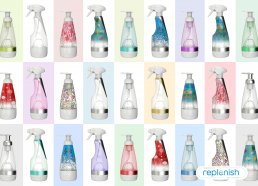Replenish manufactures a series of packaging options for cleaning products that allow for the reuse of plastic spray bottles, reducing waste generation and product transportation costs.
Replenish has developed a new concept for the cleaning industry by selling capsules of concentrated and non-harmful cleaning chemicals which fits into reusable spray bottles. A capsule containing concentrated cleaner chemicals is screwed into the spray bottle, which is then filled with water from the faucet. One capsule contains enough chemical cleaner for the spray bottle to be refilled three to four times, and when the cleaner is finished, only the capsule needs to be recycled. Replenish offers customisable packaging and partners with various brands that use the Replenish technology for their liquid cleaning products such as Amazon’s Clean Revolution brand.

Traditional cleaning products contain approximately 90% water and 10% percent actual chemical cleaner, according to Replenish. By transporting small capsules and not bottles full of water, Replenish significantly reduces the transportation costs and CO2 footprint of its cleaning products.
Plastic is a great material but we have to be smarter about how we use it. You can only light-weight a bottle so much and we’ve come to the end of that road.
Jason Foster – CEO and Founder, Replenish.
Why you should care
The Replenish bottle is 100% recyclable and is tested for at least 10,000 trigger pulls, making it last for years of daily use. Replenish aims to eliminate one billion plastic bottles from landfills and reduce the negative environmental impacts of chemicals by recycling the bottles and using only cleaning chemicals that do not harm nature or humans.
How the Global Goals are addressed

Responsible Consumption and Production
The Replenish bottle is an investment of $7 and can be used 10,000 times. The capsule costs $1 to $5 less than conventional cleaning products and can be used for several refills, addressing our throwaway habits.
Life Below Water
The cleaning chemicals are 98% plant-based, biodegradable, non-toxic to aquatic life, and pH neutral, helping to minimise environmental impacts on aquatic environments.



